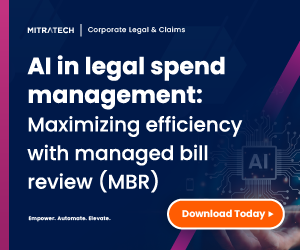Your Strategic Playbook for Securing Early Approvals
As the year comes to a close and the holiday season approaches, your calendar is likely filling up with celebrations, shopping lists, and year-end festivities. The last thing you need is the stress of scrambling to finalize your 2025 legal operations budget. Planning can often feel like a never-ending marathon while you justify the estimated cost, align priorities with stakeholders, and anticipate potential pushback — all while trying to stay ahead of competing organizational priorities.
But here’s the good news: with a proactive approach, you can get ahead of the game, secure your budget approvals early, and enjoy a worry-free season. Follow these tips to streamline your budget processes and make 2025 a success (while buying yourself more time to focus on what matters most this holiday season)!
Step One: Reflect on 2024 – Key Learnings and Performance Metrics
Reflecting on the past year’s trends and performance metrics is an essential first step in crafting a strong legal operations budget proposal for 2025. Why? The proof is in the pudding! Every dollar you request for next year is going to need justification. What better way to deliver that than with tangible, recent results that highlight key growth areas?
Consider the following during your reflection:
- What worked in 2024? Reviewing successes helps highlight where your team has delivered measurable value, such as cost savings, risk mitigation, or increased efficiency. These wins serve as proof points to justify continued or increased investment in those areas.
- Where can our team improve? By analyzing underperforming initiatives or unexpected overspending (such as outside counsel, for example), you can identify where adjustments are needed. This ensures your 2025 budget is more accurate and aligned with actual needs.
- What are our data-driven justifications? Metrics provide the hard evidence you need to build a compelling case for your budget. Whether it’s legal spend trends, outside counsel ROI, or technology adoption rates, these numbers validate your future requests to stakeholders.
- How does our budget align with organizational goals? Reflecting on trends allows you to show how the legal ops team has supported broader company objectives, such as compliance, diversity, or cost management, setting the stage for continued collaboration.
- What is our growth trajectory with the proposed legal operations budget? Understanding where you’ve been gives you clarity on where you’re headed. It ensures your budget isn’t just reactive but also proactive in addressing future challenges and opportunities.
Taking the time to review the past year will equip you with the insights you need to craft a budget that is not only realistic but also well-positioned for approval. Once you have completed step one, you have completed the groundwork for a successful planning process.
Step Two: Set Priorities for Your 2025 Legal Operations Budget
Now that you have insights from 2024’s performance in hand, the next step is setting clear priorities for 2025. This step ensures your budget is forward-looking and strategically aligned with your organization’s goals.
For instance, let’s say that in 2024, a significant portion of your budget was allocated to outside counsel, which limited your ability to invest in internal technology. However, you’ve recently seen a higher return on investment from those technology initiatives. In 2025, your priority could be to reallocate more funds toward technology adoption, ensuring you maximize the value of these investments.
Tip: Use your answer from step 1’s “how does our budget align with organizational goals?” to decipher what your priorities are for 2025. If it is not in line, it is not a priority.
By thoughtfully transitioning from reflection to priority-setting, you’re building a roadmap that ensures your legal department’s budget isn’t just reactive but a strategic tool for driving value in the new year.
Step Three: Engage Key Stakeholders Early and Often
Engaging key stakeholders early is about building relationships, gathering input, and securing buy-in for your budget proposal before it’s formally submitted. Begin by connecting with senior leaders, finance, internal legal teams, and external partners to understand who is a stakeholder and what their needs and expectations are for the upcoming year.
Once you have identified your stakeholder group:
- Hold Pre-Budget Meetings: Schedule one-on-one discussions to gather input and brainstorm priorities, ensuring alignment with broader goals.
- Share Preliminary Plans: Provide early drafts of your budget and seek feedback to refine your proposal.
- Align on Priorities: Collaborate to identify critical goals for 2025, such as compliance or cost-efficiency, and ensure the budget reflects those priorities.
4. Present Data: Use metrics and data from the previous year to justify your budget allocations, demonstrating their potential impact.
5. Gain Early Commitments: Secure verbal support from key stakeholders for specific budget areas, identifying champions to advocate for your proposal.
6. Maintain Ongoing Communication: Keep stakeholders informed throughout the process, addressing concerns and ensuring everyone is aligned for final approval.
This proactive approach ensures that your budget is well-aligned with organizational priorities and increases the chances of a quick and smooth approval process.
Step Four: Build a Detailed Legal Operations Budget Proposal
In order to get quick budget approvals, it is important to provide clear and detailed proposals. This involves creating a clear, data-driven plan that outlines your department’s resource needs, aligns with organizational goals, and demonstrates value.
Your budget proposal should include much of what we have already discussed in steps 1 and 2 above, plus more.
Use the following for your proposal’s index:
- Executive Summary
- Past Performance Review
- 2025 Priorities
- Expense Breakdown
- Cost-Benefit Analysis
- Risk Assessment
- Implementation Timeline
- Supporting Documentation (data and reports used to make decisions)
- Stakeholder Collaboration
- Call to Action
By following these steps, you’ll create a budget proposal that is thorough, aligned with organizational goals, and backed by data, making it easier to secure approval and deliver results in 2025.
Step Five: Bring in the Tools and Technology for More Streamlined Budgeting Next Year
Budgeting and approvals can sometimes feel like a full-time job (especially at this time of year), which is when AI-driven software aimed at equipping your legal operations teams with more accurate spend insights and visibility into billing guidelines can come in handy.
You could track spending trends from the past year, for example, highlighting areas where budgets were over or under-utilized. This significantly cuts the time you would spend manually going back on past years’ analytics and allows you to accurately justify adjustments for the upcoming year.
Beyond this accuracy and efficiency, legal spend tools enhance transparency. Stakeholders are more likely to approve budgets when they can see detailed breakdowns supported by real-time data. Visualization features, such as dashboards and charts, make complex financial information accessible and engaging, which fosters better understanding and collaboration.
And ultimately, integrating tools and technology demonstrates a forward-thinking approach, positioning your legal department as efficient, strategic, and aligned with broader organizational goals.
Staying Agile and Ready for Success in 2025 and Beyond
Securing approval on your legal operations budget early isn’t just about ticking a box — it’s about setting your team up for a successful and strategic year. However, it is important to note the work doesn’t stop once your budget is approved.
Staying agile throughout the year is essential to adapting to unforeseen challenges, shifting priorities, or new opportunities. Regularly review your spending, assess the impact of your initiatives, and adjust as needed to ensure alignment with organizational goals. This not only maximizes the value of your approved legal operations budget but also demonstrates your ability to respond strategically, building trust and credibility with stakeholders.
With thoughtful planning and a flexible mindset, you can enter 2025 confident in your department’s ability to meet goals and deliver value, leaving more room to focus on your team’s success and innovation throughout the year.

Our focus? On your success.
Schedule a demo, or learn more about Mitratech’s products, services, and commitment.





